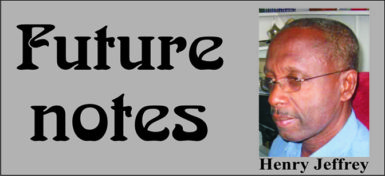
The independence agreement that preceded Guyana’s political break from the British crown required that `the ownership of lands, rights of occupancy and other legal rights held by custom or tradition be legally recognized without distinction or disability’ and the 1967/69 Amerindian Lands Commission was established to make this a reality. That commission, which included foreigners to help the extant PNC/United Force government enhance its neutrality, travelled widely in Guyana and held discussions with most of the indigenous communities and leaders. It recommended that ‘128 indigenous communities receive title to 24,000 square miles’ at the time the first peoples were demanding 43,000 square miles or one half of Guyana (‘Our Land, Our Life, Our Culture: The Indigenous Movement In Guyana:’ Cultural Survival Quarterly Magazine, December 1999).
The 1976 Amerindian Act designated 77 areas comprising about 16% of Guyana as Amerindian land (in passing, perhaps because of his Amerindian heritage and/or being far ahead of his time in trying to develop an holistic national culture, Forbes Burnham instituted and left us significant national indigenous imageries: the Golden Arrow Head, Mashramani, the Cacique Crown, Timehri district/airport, etc (SN: 11/09/2009)). Notwithstanding the noise the PPP/C now makes in support of the indigenous land issue, up to 1999, only 6,000 square miles had been titled, all under the PNC regime, and the indigenous people were complaining that the PPP/C ‘government is going to great lengths to ensure that additional areas are not recognized. More than 50 communities remain without any legal guarantees for their lands’ (Ibid).
However, whatever its initial inclinations were towards the indigenous land issue, once it became clear that its dependence on the Indian population to keep it in office was tenuous, the PPP/C vigorously set about trying to win first peoples’ support. The Amerindian Act of 2006, with its clear commitments to indigenous land demarcation, was an important part of that strategy, and between 2001 and 2015 the party made significant headway, increasing its support in the hinterland regions of 1, 7, 8 and 9 by nearly 55%.
With this as a backdrop, in August 2016, during one of his public interest programmes, President David Granger is reported to have promised to create by December 2016 a ‘form of the Indigenous Peoples’ Lands Commission which was first established in 1966’ (SN: 04/09/2016). The country now knows what that ‘form’ is and it would be no exaggeration to say that the main indigenous peoples’ stakeholders are understandably up in arms against it. The ‘Commission of Inquiry’ is ‘to examine and make recommendations to resolve issues and uncertainties surrounding the claims of Amerindian Land titling, the individual, joint or communal ownership of lands acquired by freed Africans and any other matter relative to land titling in Guyana.’
After their historical struggle and achievements, it is hardly surprising that that the president’s proposal has sent shivers down the spine of the first peoples and their leadership. Perhaps the establishment of a COI is merely reflective of the formal military response to these types of situation, but the indigenous peoples must have thought that their issue had gone long past inquiry and should be firmly in the implementation stage!
To make matters worse, in spite of the fact that in his August statement the president indicated that at least he formally understood that, ‘Land is life for the Indigenous People’ and that the demarcation process ‘is not something that can be embarked on unilaterally.’ The ink was not yet dry on his pronouncement when the National Toshaos Council claimed that as ‘a body comprising all Toshaos of Guyana and a representative body of the indigenous peoples of Guyana, having never been consulted in the formation of such a body, [it] cannot, with any degree of sanity nor confidence, respect such a body, and will refuse to cooperate with such a body’ (SN: 29/03/2017).
To this declaration, sliding even deeper into formalism, the president’s reported response was that he announced his intention ‘at the National Toshaos Conference last year’ and ‘I certainly did not pick Mr. David James’s name out of a hat. A recommendation had to be made to me.’ That Mr. James is a lawyer and legal advisor to the NTC does not necessarily mean that the NTC was actually consulted or participated as a body in choosing him!
The indigenous population, which is nearly 70,000 and growing is too sizable a voting block for a regime that came to office with a majority of less than 5,000 to alienate. But even if it is argued that electoral politics should not be the sole determinant of important national policy, perhaps, precisely because of its general military orientation, the administration appears unable to also grasp that the social cohesion it has so far only formally committed itself to cannot be created by force but needs a cooperative social framework.
Also, let’s be frank, for historical reasons, much of which conventional wisdom associates with the behaviour of the military during its sojourn in the hinterland, generally Amerindians have an antipathy toward it, and among a large section of the Guyanese population this government is viewed broadly as an African/military contraption. As the president recognised, land ownership is central to the psyche of our indigenous peoples and this behaviour of the government will only further reinforce their negative perception of the government and its associates.
Why then adopt an approach which is certain to further alienate a group that given its own history should have been a natural ally of Africans in their struggle for ancestral land? Why create an opening for those opposed to the Africans being given land to do so on the pretext of opposing the process? Is it that the government thinks that by formally coupling the African and Amerindian land issues it adds legitimacy and thus makes it simpler to justify satisfying the land demands of its main African constituency? These and other questions will be considered in the next column.
henryjeffrey@yahoo.com




